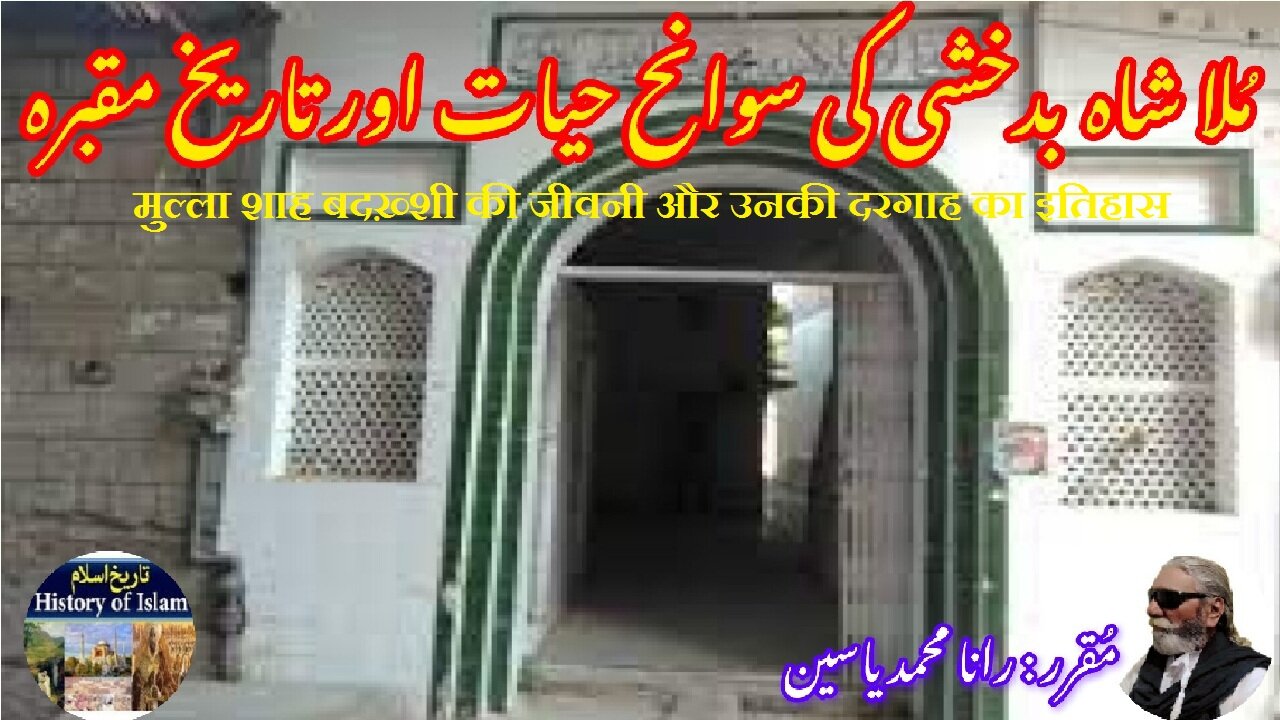Premium Only Content

Mullah Shah Badakhshi and his shrine ملا شاہ بدخشی کی سوانح عمری اور ان کے مزار کی تاریخ
@islamichistory813 #mullah #shah #badakhshi #sufisaint #cultural #heritage #biography #islamic #mysticism #islamic #philosophy #shrine #historical #figures #political #leaders #islamic #scholar
Biography of Mullah Shah Badakhshi and the history of his shrine
Dekhti Aankhooon aur sountay kaanoon ko Asslamoalaikum, sisters, brothers friends and elders, in informative series videos of Islamic ascolars, sufisaints, cultural heritages, islamic philosophys, islamic mysticisms and historical figures. today we are describing biography of Mullah Shah Badakhshi and the history of his shrine.
Mullah Shah Badakhshi, also known simply as Mullah Shah, was a prominent 17th-century Islamic scholar, revered Sufi saint, and spiritual heir to the great mystic Mian Mir (1550–1635). His full name was Shah Muhammad, though he was affectionately referred to as “Hazrat Akhund” by the disciples of Mian Mir. Born in the village of Araska in the Rustaq region of Badakhshan, now part of modern-day Afghanistan, Mullah Shah belonged to a respected lineage of Islamic scholars. His father was a Qazi, a judge of Islamic law, and this scholarly environment no doubt contributed to the early development of his religious and spiritual understanding. His name "Badakhshi" is derived from his native region, and he became known as a deeply influential figure in the Qadiri order of Sufism.
Mullah Shah played a central role in spreading Sufi teachings during the height of the Mughal Empire, and he holds a special place in the spiritual history of the subcontinent. He became the spiritual guide of Dara Shikoh, the Mughal prince and philosopher who was the eldest son of Emperor Shah Jahan and the brother of Princess Jahanara Begum. Both Dara and Jahanara were deeply drawn to the Sufi path, particularly the Qadiri order, and after the death of Mian Mir, Dara Shikoh sought another spiritual mentor. His journey eventually led him to Kashmir, where he met Mullah Shah and became his devoted disciple. Dara Shikoh writes reverently about his relationship with Mullah Shah in his famous work *Sakinatul Awliya*, especially in the chapter titled "Mulla Shah Badakhshi," where he proclaims himself a humble servant and follower of the saint. It was under Mullah Shah’s guidance that Dara was formally initiated into the Qadiri Sufi order.
The exact date of Mullah Shah Badakhshi’s death is not universally agreed upon in historical records. However, scholars generally place his passing sometime in the latter half of the 17th century, following the decline of his famous disciple Dara Shikoh, who was executed in 1659 by his brother Aurangzeb. Despite the lack of a precise date, the spiritual impact of Mullah Shah’s teachings continued to grow well beyond his lifetime, influencing Sufi thought and literature across the region. His memory is preserved through the writings of his disciples and the reverence of Sufi communities.
The final resting place of Mullah Shah Badakhshi is in the region of Kashmir, where he spent a significant portion of his life engaged in spiritual instruction and guiding seekers on the Sufi path. His shrine is located in Srinagar, the capital city of Jammu and Kashmir, India. The shrine lies in the vicinity of the famous Pari Mahal, a terraced garden structure on the Zabarwan mountain range overlooking Dal Lake. According to historical accounts, this area was used by Prince Dara Shikoh for meditation and spiritual gatherings under the guidance of Mullah Shah. It is widely believed that Dara Shikoh himself helped establish the site and may have contributed to the development of Mullah Shah’s shrine as an act of devotion to his beloved spiritual master.
Though no grand imperial structure like those seen in the major Mughal tombs, the shrine of Mullah Shah remains an important spiritual site and a symbol of the intellectual and mystical flourishing that occurred during the Mughal era. The architecture around the shrine reflects the serene and modest aesthetics of Sufi culture—peaceful, reflective, and unadorned by excess. Unlike the elaborate tombs of emperors, the shrine of Mullah Shah is a place of quiet reflection, emphasizing the humility and spiritual focus that characterized his teachings. Pilgrims and spiritual seekers from across the region continue to visit the site, offering prayers and paying their respects to a master who played a pivotal role in shaping the Sufi landscape of South Asia.
While the shrine has not been widely promoted in modern times and remains relatively lesser known compared to those of other famous saints, it remains spiritually significant. Preservation efforts by local communities and occasional historical interest help maintain the sanctity of the site. For many, visiting the shrine of Mullah Shah in Srinagar is not merely an act of historical interest but a spiritual journey to connect with a figure whose teachings bridged the gap between divine knowledge and royal power, between mysticism and statecraft, as embodied in his disciple Dara Shikoh.
In conclusion, Mullah Shah Badakhshi’s life and legacy are deeply rooted in the spiritual traditions of the Indian subcontinent. His death, though not precisely dated, marked the end of an era of deep mysticism and royal Sufi patronage. His shrine in Srinagar, likely established or at least endorsed by Prince Dara Shikoh, continues to serve as a humble yet powerful reminder of his role as a teacher, mentor, and torchbearer of the Qadiri Sufi order.
With this, we seek your permission until tomorrow, tomorrow we will describe the biography of Badi al-Din and the history of his Shrine.
Allah Hafiz
==============================
-
 12:36
12:36
ISLAMIC HISTORY
2 hours agoIslamic History Episode 243 Beginning of Samania दौलत-ए-समानिया की शुरुआत دولت سا ما نیہ کی ابتدا
1 -
 LIVE
LIVE
LFA TV
13 hours agoLIVE & BREAKING NEWS! | WEDNESDAY 10/1/25
4,533 watching -
 30:49
30:49
Rethinking the Dollar
1 hour agoMarkets Panic: Government Shutdown Sends Gold & Bitcoin Higher | Morning Check-In: Let's Talk...
6.22K -
 LIVE
LIVE
Trumpet Daily
1 hour agoTrumpet Daily LIVE | Oct. 1, 2025
440 watching -
 1:00:55
1:00:55
VINCE
3 hours agoSOMBRERO-GATE! | Episode 137 - 10/01/25
223K169 -
 LIVE
LIVE
MYLUNCHBREAK CHANNEL PAGE
4 hours ago1000's of Miles of Tunnels
732 watching -
 1:08:12
1:08:12
The Big Mig™
3 hours agoSchumer Government Shutdown Screwing America AGAIN!
22K9 -
 DVR
DVR
Bannons War Room
7 months agoWarRoom Live
38.8M9.03K -
 1:09:26
1:09:26
Benny Johnson
2 hours agoDemocrats Throw Hysterical MELTDOWN As Trump Gives Them 'Trump 2028' Hats, Trolls With 'Racist' Meme
47K54 -
 1:35:09
1:35:09
Dear America
4 hours agoDems Cause a Gov SHUTDOWN!! Remember THEY HATE YOU! + Bomb Threat At TPUSA Event!!
102K78